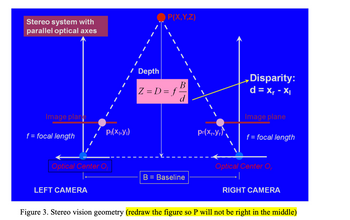
Database System Concepts
7th Edition
ISBN: 9780078022159
Author: Abraham Silberschatz Professor, Henry F. Korth, S. Sudarshan
Publisher: McGraw-Hill Education
expand_more
expand_more
format_list_bulleted
Question
- Estimate the accuracy of the simple stereo system (Figure 3) assuming that the only source of noise is the localization of corresponding points in the two images. Discuss the dependence of the error in depth estimation as a function of disparity error, depth itself, the baseline width and the focal length, respectively.
Hint: Z = fB/d; Take the partial derivatives of Z with respect to d, B, f, respectively.

Transcribed Image Text:**Stereo Vision Geometry**
The figure illustrates the concept of stereo vision geometry, particularly focusing on a stereo system with parallel optical axes.
**Components:**
- **P(X,Y,Z):** The point in space being observed.
- **Left Camera:**
- Optical Center \( O_l \).
- Image Plane: Plotted with point \( p_l(x_l,y_l) \).
- **Right Camera:**
- Optical Center \( O_r \).
- Image Plane: Plotted with point \( p_r(x_r,y_r) \).
**Key Elements:**
- **Baseline (\( B \)):** The distance between the optical centers of the left and right cameras.
- **Focal Length (\( f \)):** The distance from the optical center to the image plane in both cameras.
- **Disparity (\( d \)):** Calculated as \( d = x_r - x_l \), representing the difference in the x-coordinates of points on the image planes.
- **Depth (\( Z \) or \( D \)):** Estimated using the formula \( Z = D = \frac{f \cdot B}{d} \), associating depth with the disparity and baseline.
**Note:**
The figure includes a suggestion to redraw so that the point P is not positioned in the middle, optimizing the diagram for clarity and understanding.
This diagram serves as an educational tool to explain how stereo cameras can be used to estimate the depth and position of objects in three-dimensional space by using parallel optical axes.
Expert Solution
This question has been solved!
Explore an expertly crafted, step-by-step solution for a thorough understanding of key concepts.
This is a popular solution
Trending nowThis is a popular solution!
Step by stepSolved in 2 steps

Knowledge Booster
Learn more about
Need a deep-dive on the concept behind this application? Look no further. Learn more about this topic, computer-science and related others by exploring similar questions and additional content below.Similar questions
- Attach Matlab code and output screenshot.arrow_forwardWhat is the implicit equation of the plane through 3D points (1,0,0), (0, 1, 0), and (0, 0, 1)? What is the parametric equation? What is the normal vector to this plane?arrow_forwardA signal's spectrum contains four components: -2500 Hz, -1700 Hz, +1700 Hz, and +2500 Hz. If we assume this spectrum is the product of two sinusoidal signals, what are the frequencies of the two signals whose product gives rise to this spectrum? 400 Hz and 2100 Hz 1700 Hz and 2500 Hz 1300 Hz and 2100 Hz 800 Hz and 4200 Hzarrow_forward
- Describe the procedure for Monte Carlo localization using a particle filter.arrow_forward2. calculates the trajectory r(t) and stores the coordinates for time steps At as a nested list trajectory that contains [[xe, ye, ze], [x1, y1, z1], [x2, y2, z2], ...]. Start from time t = 0 and use a time step At = 0.01; the last data point in the trajectory should be the time when the oscillator "hits the ground", i.e., when z(t) ≤ 0; 3. stores the time for hitting the ground (i.e., the first time t when z(t) ≤ 0) in the variable t_contact and the corresponding positions in the variables x_contact, y_contact, and z_contact. Print t_contact = 1.430 X_contact = 0.755 y contact = -0.380 z_contact = (Output floating point numbers with 3 decimals using format (), e.g., "t_contact = {:.3f}" .format(t_contact).) The partial example output above is for ze = 10. 4. calculates the average x- and y-coordinates 1 y = Yi N where the x, y, are the x(t), y(t) in the trajectory and N is the number of data points that you calculated. Store the result as a list in the variable center = [x_avg, y_avg]…arrow_forwardMatlab: Create a linearly polarized light with its polarization along the X axis. (ii) Specify the polarization angle of the linear polarizer with respect to the X axis. (iii) Calculate the fields EX(t) and EY(t) after the polarizer. (iv) Similar with (a) (iii), plot the output vectorial fields ( EX(t), EY(t) after the polarizer) and the input vectorial fields (EX(t), EY(t) before the polarizer) in ONE time-lapse plot.arrow_forward
arrow_back_ios
arrow_forward_ios
Recommended textbooks for you
 Database System ConceptsComputer ScienceISBN:9780078022159Author:Abraham Silberschatz Professor, Henry F. Korth, S. SudarshanPublisher:McGraw-Hill Education
Database System ConceptsComputer ScienceISBN:9780078022159Author:Abraham Silberschatz Professor, Henry F. Korth, S. SudarshanPublisher:McGraw-Hill Education Starting Out with Python (4th Edition)Computer ScienceISBN:9780134444321Author:Tony GaddisPublisher:PEARSON
Starting Out with Python (4th Edition)Computer ScienceISBN:9780134444321Author:Tony GaddisPublisher:PEARSON Digital Fundamentals (11th Edition)Computer ScienceISBN:9780132737968Author:Thomas L. FloydPublisher:PEARSON
Digital Fundamentals (11th Edition)Computer ScienceISBN:9780132737968Author:Thomas L. FloydPublisher:PEARSON C How to Program (8th Edition)Computer ScienceISBN:9780133976892Author:Paul J. Deitel, Harvey DeitelPublisher:PEARSON
C How to Program (8th Edition)Computer ScienceISBN:9780133976892Author:Paul J. Deitel, Harvey DeitelPublisher:PEARSON Database Systems: Design, Implementation, & Manag...Computer ScienceISBN:9781337627900Author:Carlos Coronel, Steven MorrisPublisher:Cengage Learning
Database Systems: Design, Implementation, & Manag...Computer ScienceISBN:9781337627900Author:Carlos Coronel, Steven MorrisPublisher:Cengage Learning Programmable Logic ControllersComputer ScienceISBN:9780073373843Author:Frank D. PetruzellaPublisher:McGraw-Hill Education
Programmable Logic ControllersComputer ScienceISBN:9780073373843Author:Frank D. PetruzellaPublisher:McGraw-Hill Education

Database System Concepts
Computer Science
ISBN:9780078022159
Author:Abraham Silberschatz Professor, Henry F. Korth, S. Sudarshan
Publisher:McGraw-Hill Education

Starting Out with Python (4th Edition)
Computer Science
ISBN:9780134444321
Author:Tony Gaddis
Publisher:PEARSON

Digital Fundamentals (11th Edition)
Computer Science
ISBN:9780132737968
Author:Thomas L. Floyd
Publisher:PEARSON

C How to Program (8th Edition)
Computer Science
ISBN:9780133976892
Author:Paul J. Deitel, Harvey Deitel
Publisher:PEARSON

Database Systems: Design, Implementation, & Manag...
Computer Science
ISBN:9781337627900
Author:Carlos Coronel, Steven Morris
Publisher:Cengage Learning

Programmable Logic Controllers
Computer Science
ISBN:9780073373843
Author:Frank D. Petruzella
Publisher:McGraw-Hill Education